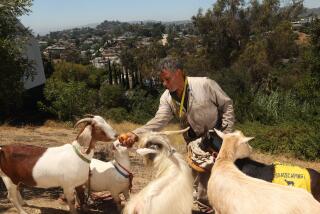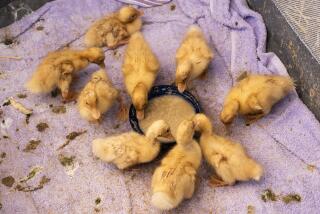Trailer Park Manger Cries Foul Over Pesky Invasion of Dirty Birds
- Share via
OCEANSIDE — Lloyd Thompson is at his wits’ end.
Every year, roundabout the end of October, hundreds of coots--commonly known as mud hens--descend on Thompson’s mobile home park, taking up residence in and around the park’s eight man-made lakes.
For the next six months, the scrappy slate-black birds nibble and scratch at Thompson’s carefully tended lawns, snoop around in residents’ carports and plunder vegetable gardens. What’s worse, the migratory fowl leave in their wake a virtual carpet of coot droppings--”85 pounds per bird per season,” Thompson estimates.
A soft-spoken, pipe-smoking man who has managed the Laguna Mobile Home Park in northeast Oceanside for five years, Thompson has tried everything to convince the coots to roost elsewhere--scaring them, shooing them, screaming at them, even trapping a few in hopes of giving the flock a message.
Nothing has worked.
Now, with the pesky birds’ 1985 debut here just around the corner, Thompson wants to get dead serious about the problem: he plans to grab his 410-gauge light-load shotgun and shoot the coots, one by one.
“What else can I do?” said Thompson, a one-time champion marksman. “It’s not like I’d be out there shooting like crazy. I’d get in at close range, 20 or 30 feet, and pick ‘em off.”
Unfortunately for Thompson--and fortunately for his unsuspecting targets--an Oceanside ordinance prohibits anyone except a “duly appointed peace officer” from discharging firearms within the city limits. Frustrated but law-abiding, the mobile home park manager has asked the City Council to amend the code so he can shoot his coots.
Although he may suspect the coots have singled him out, Thompson is not the first to feel harassed by the waterfowl--and what comes out of them. The small but gutsy birds, slow-flying members of the rail family that have lobed feet and resemble ducks, are particularly notorious for wreaking havoc on golf courses.
Because of their numerous ponds and lush, insect-laden greens, the courses make ideal wintering grounds for the birds, which riddle the golfing surface with holes as they forage for bugs and mar the sleek green expanses with mounds of mucky coot droppings.
Throughout Southern California, exasperated golf course managers have gotten tough with the coots, obtaining permits to shoot them from the U.S. Fish and Wildlife Service. An agency spokeswoman said as many as 100 such permits--which allow the shooting of a limited number of the birds providing there are no homes within 150 yards--are issued annually in the region stretching from Ventura through San Diego counties.
“They’re messy buggers--real nuisance birds--and they don’t even make good eating,” said Gloria Arzola, an administrative officer at U.S. Fish and Wildlife’s Long Beach office. “Some people try to relocate them, but usually they’ll beat you home. And there are tons of them. So shooting seems to be the most popular method.”
San Diego County is no exception.
In 1970, the head pro at Whispering Palms Golf Club in Rancho Santa Fe led a band of regular players on an impulsive--and permitless--shooting spree, during which “we mowed down hundreds of them,” said the pro, who asked that his name not be used.
“We wiped them out, at least for that season,” he recalled recently. “You should have heard the environmentalists scream.”
At the Chula Vista Municipal Golf Course, flocks of coots are killed each winter during a legal and more orderly ritual--by police officers bearing U.S. Fish and Wildlife permits. Still, new birds usually return each fall, Assistant City Manager Gene Asmus said.
In North County, the Escondido Country Club has had its own share of coot troubles.
“They stroll onto the fairways and do their thing all over the place,” one veteran golfer said. “You get your putter in it. It’s a mess.”
Last February, over the protests of some pro-coot residents, Escondido council members amended an ordinance prohibiting shooting in the city limits to permit a coot hunt at the course. But by the time the various approvals were in place, the savvy coots had flown the coop.
Lloyd Thompson insists his battle with the birds rivals all.
In the early days, Thompson’s attempts to drive the coots away were rather primitive. He blew air into paper sacks and popped them, producing a noise that ruffled few feathers. He hurled sticks and stones at the coots and hollered at them. They hardly budged.
Feeling desperate, he even followed one resident’s advice and put a large plastic swan in the water in an effort to intimidate the coots and convince them to scram. No luck.
“Heck, the things just got together and pushed that swan around the lake,” Thompson said. “They played with the thing.”
Seeking advice, Thompson called the U.S. Fish and Wildlife Service, the state Department of Fish and Game and the Humane Society, but “nobody had the answer,” he said.
Last week, Thompson outlined his problem to the City Council during the meeting’s public input period and asked that he be permitted to shoot the birds.
“They’re ruining the place,” Thompson told the council. “The stuff they leave behind sterilizes the ground so new grass won’t grow. You can’t scare ‘em off. They just walk double-time ahead of you and say ‘catch me if you can.’ ”
City officials, trying unsuccessfully to stifle chuckles, listened politely and asked a few questions of Thompson.
“What would you do with the bodies?” Councilman John MacDonald wondered.
“Have you tried tear gas?” Councilman Ted Marioncelli wanted to know.
“What about the social and political ramifications of allowing (the shooting)?” City Atty. Charles Revlett asked.
Thompson wasn’t laughing. And finally, council members agreed to refer the matter to their staff for further investigation.
Even if the city amends the code to permit the coot hunt, Thompson may have trouble obtaining a Fish and Wildlife Service permit, an agency official said. Regulations prohibit shooting within 150 yards of a dwelling, and mobile homes in Thompson’s park surround the coot-infested lakes.
And if the city does not grant Thompson the waiver?
“That,” he said with a grin, “is between me and the coots.”
More to Read
Sign up for Essential California
The most important California stories and recommendations in your inbox every morning.
You may occasionally receive promotional content from the Los Angeles Times.













